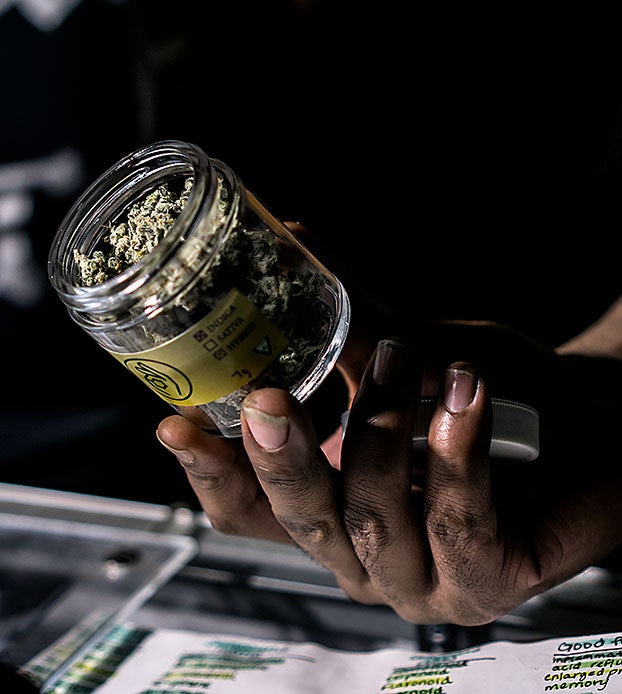On July 1st, 2021, new cannabis legalization are going into effect in Connecticut, New Mexico, and Virginia, just a couple days after a recreational cannabis legalization measure went into effect in South Dakota.
Nearly half of all Americans now live in states where cannabis is legal for adult use. But in addition to the 18 states with legal adult-use (as well as medical), there are another 18 states that have fully functioning medical marijuana programs. In these three dozen states, from the West Coast to the Midwest to the South and the Northeast, patients use cannabis to treat countless medical conditions and everyday ailments.
A study published in May in the “Journal of Cannabis Research” looked at 33 medical cannabis clinics in five states (Maryland, Massachusetts, Maine, Colorado, and Connectitut) and examined what the patients at those clinics reported as their relevant health conditions. As of July 1, 2021, all five states had both adult-use and medical cannabis programs.
➤ Get your medical card now with The Cannigma Medical
To varying degrees, the three most common uses of medical marijuana in Massachusetts, Maine, and Maryland were to treat chronic pain, anxiety, and back and neck problems. In Colorado, 78.7% of patients reported chronic pain as their primary condition, while in Connecticut 70.4% listed post-traumatic stress disorder.
The study examined a total of 53,693 patients, including 27,892 from Massachusetts, 16,434 from Colorado, 4,591 from Maine, 2,643 from Connecticut, and 2,403 from Maryland. Across all of the states, males made up 60% of the patients, and the average age was 45.5. In addition, 87.5% of the patients identified as white, including 96% in Maine.
The most common medical conditions
| State | Most common health condition | 2nd most common | 3rd most common |
| Massachusetts | Anxiety (21.7%) | Chronic pain (19.4%) | Back and neck problems (9.8%) |
| Colorado | Chronic pain (78.7%) | Muscle spasms (13%) | Back and neck problems (10%) |
| Maine | Chronic pain (35.9%) | Anxiety (33.6%) | Back and neck problems (28.8%) |
| Connecticut | Post-Traumatic Stress Disorder (70.4%) | Anxiety (58%) | Depression (38.4%) |
| Maryland | Stress (23.8%) | Chronic pain (23.7%) | Anxiety (20.3%) |
| Average | Chronic pain (38.8%) | Anxiety (28.3%) | Back and neck problems (23.7%) |
There are dozens of medical conditions which qualify patients for medical marijuana licenses in the United States, as long as a qualifying physician asserts that the patient has said condition and that cannabis could be of assistance.
We did our own survey of five states across the country to see which conditions are the most common among medical marijuana recipients.
One clear takeaway is that severe and/or chronic pain is a top qualifying condition in all states, but there are other surprises. Mainly, PTSD is consistently one of the main qualifying conditions, arguably at an extent that many observers may find surprising.
Cancer, while originally one of the leading conditions that people receive medical marijuana to treat long before such programs became legal in states across the country, makes up a far lower share of the qualifying conditions for patients today.
Oregon
Oregon was an early adopter of medical marijuana, which was legalized in the state by a ballot measure in 1998. In 2014 the state legalized recreational cannabis and as of 2021 has one of the highest concentrations of legal cannabis retail stores in the country, though the total number of medical cannabis patients (22,566) is relatively low compared to the state’s population. The most common conditions for medical marijuana recipients in state as of April, 2021 were:
| Condition | Number of patients | Percentage of total |
| Severe pain | 19,607 | 86.9% |
| Spasms | 4,937 | 21.9% |
| PTSD | 3,440 | 15.2% |
| Nausea | 2,358 | 10.4% |
| Cancer | 1,327 | 5.9% |
New Mexico
Since June 29, 2021, anyone over the age of 21 in New Mexico can legally possess up to 2 ounces of cannabis, 16 grams of concentrate, and 800 milligrams of edible cannabis. The law also allows for the cultivation of up to 12 mature cannabis plants at home, or 6 if there is only one adult in the house.
Long before New Mexico legalized recreational cannabis, the Land of Enchantment approved a medical marijuana program in 2007. There are currently dozens of licensed dispensaries across the state. New Mexico stands out among medical marijuana states for the fact that PTSD is the leading qualifying condition. Overall, the most common conditions for medical marijuana among the state’s 117,517 recipients as of May, 2021 are:
| Condition | Number of patients | Percentage of total |
| PTSD | 63,830 | 54.3% |
| Severe chronic pain | 35,866 | 30.5% |
| Cancer | 5,717 | 4.9% |
| Painful Peripheral Neuropathy | 2,377 | 2% |
| Inflammatory autoimmune-mediated arthritis | 2,010 | 1.7% |

Michigan
Michigan has had a legal medical marijuana program since 2008 and in 2018 added 11 new qualifying conditions including chronic pain, autism, and inflammatory bowel disease. Michigan also honors out-of-state medical marijuana licenses, and allows adults to privately grow up to 12 marijuana plants. As of May 31, 2021, the most common conditions for the state’s 252,414 medical marijuana recipients are:
| Condition | Number of patients* | Percentage of total |
| Chronic pain | 157,481 | 62.39% |
| Severe and chronic pain | 107,000 | 42.54% |
| Arthritis | 55,000 | 21.89% |
| Muscle spasms | 23,000 | 9.16% |
| Severe nausea | 16,000 | 6.35% |
New Hampshire
Since 2017, anyone in the Granite State in possession of less than three-quarters of an ounce of marijuana flower or five grams or less of hash or concentrates is subject to violation and not a criminal offense. The state has had a legal medical marijuana program since 2013, and in its 2020 end-of-year data report, these were the most common qualifying conditions for the state’s 10,688 medical mairjuana patients:
| Condition | Number of patients | Percentage of total |
| Moderate to severe chronic pain | 5,356 | 50% |
| Severe pain that has not responded to other medications | 1,846 | 17.27% |
| PTSD | 1,568 | 14.67% |
| Spinal cord injury or disease | 1,005 | 9.4% |
| Cancer | 839 | 7.8% |
Arkansas
Medical marijuana came to the Ozarks after voters in Arkansas voted in favor of legalization in 2016, and the first medical dispensary opened in 2019. According to the Arkansas Department of Health’s end-of-year fiscal report for 2020, these were the top qualifying conditions for residents of the Natural State:
| Condition | Number of patients | Percentage of total |
| Intractable pain that doesn’t respond to other treatments for more than 6 months | 19,728 | 32.5% |
| PTSD | 12,546 | 20.6% |
| Severe arthritis | 8,290 | 13.6% |
| Peripheral neuropathy | 4,260 | 7% |
| Fibromyalgia | 3,474 | 5.7% |
Many conditions, one plant
In its early days medical marijuana may have been mainly known as a treatment for glaucoma, cancer, or AIDS. Today it is seen as a legitimate and helpful treatment for pain, anxiety, depression, and a variety of other health conditions that seems to expand with each passing day.
It’s clear to any observer that the world of medical marijuana is evolving and as knowledge of its therapeutic benefits continues to expand, the uses of medicinal marijuana and the patients who it provides relief should only grow.
Sign up for bi-weekly updates, packed full of cannabis education, recipes, and tips. Your inbox will love it.

 Shop
Shop Support
Support
















